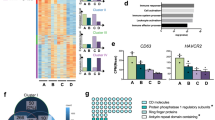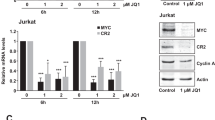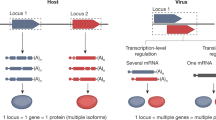Abstract
THE rex gene of the type I human T-cell leukaemia virus (HTLV-I) encodes a phosphorylated nuclear protein of relative molecular mass 27,000 which is required for viral replication1–3. The Rex protein acts by promoting the cytoplasmic expression of the incompletely spliced viral messenger RN As that encode the virion structural proteins4,5. To identify the biologically important peptide domains within Rex, we introduced a series of mutations throughout its sequence. Two distinct classes of mutations lacking Rex biological activity were identified. One class corresponds to trans-dominant repressors as they inhibit the function of the wild-type Rex protein. The second class of mutants, in contrast, are recessive negative, rather than dominant negative, as they are not appropriately targeted to the cell nucleus. These results indicate the presence of at least two functionally distinct domains within the Rex protein, one involved in protein localization and a second involved in effector function. The trans-dominant Rex mutants may represent a promising new class of antiviral agents.
This is a preview of subscription content, access via your institution
Access options
Subscribe to this journal
Receive 51 print issues and online access
$199.00 per year
only $3.90 per issue
Buy this article
- Purchase on Springer Link
- Instant access to full article PDF
Prices may be subject to local taxes which are calculated during checkout
Similar content being viewed by others
References
Inoue, J., Yoshida, M. & Seiki, M. Proc. natn. Acad. Sci. U.S.A. 84, 3653–3657 (1987).
Kiyokawa, T. et al. Proc. natn Acad. Sci. U.S.A. 82, 8359–8363 (1985).
Siemi, H. et al. Cell 55, 197–209 (1988).
Hidaka, M., Inoue, J., Yoshida, M. & Seiki, M. EMBO J. 7, 519–523 (1988).
Hanly, S. et al. Genes Dev., in the press.
Cullen, B. R. Cell 46, 973–982 (1986).
Seiki, M., Inoue, J., Hidaka, M. & Yoshida, M. Proc. natn. Acad. Sci. U.S.A. 85, 7124–7128 (1988).
Matsushita, S. et al. Proc. natn. Acad. Sci. U.S.A. 83, 2672–2676 (1986).
Malim, M. H., Hauber, J., Le, S. Y., Maizel, J. V. & Cullen, B. R. Nature 338, 254–257 (1989).
Hadzopoulou-Cladaras, M. et al. J. Virol. 63, 1265–1274 (1989).
Fleber, B. K., Hadzopoulou-Cladaras, M., Cladaras, C., Copeland, T. & Pavlakis, G. N. Proc. natn. Acad. Sci. U.S.A. 86, 1495–1499 (1989).
Gutman, D. & Goldenberg, C. J. Science 241, 1492–1495 (1988).
Emerman, M., Vazeux, R. & Peden, K. Cell 57, 1155–1165 (1989).
Rimsky, L. et al. Nature 335, 738–740 (1988).
Malim, M. H., Hauber, J., Fenrick, R. & Cullen, B. R. Nature 335, 181–183 (1988).
Triezenberg, S. J., Kingbury, R. C. & McKnight, S. L. Genes Dev. 2, 718–729 (1988).
Wachsman, W. et al. Science 235, 674–677 (1987).
Malim, M., Böhnlein, S., Hauber, J. & Cullen, B. R. Cell 58, 205–214 (1989).
Green, M., Ishino, M. & Loervenstein, P. M. Cell 58, 215–223 (1989).
Baltimore, D. Nature 335, 395–396 (1988).
Nakamaye, G. & Eckstein, F. Nucleic Acids Res. 14, 9679–9698 (1986).
Seiki, M., Hattori, S., Hirayama, Y. & Yoshida, M. Proc. natn. Acad. Sci. U.S.A. 80, 3618–3622 (1983).
Cullen, B. R. Meth. Enzym. 152, 692–704 (1987).
Feinberg, M. R., Jarrett, R. F., Aldovini, A., Gallo, R. C. & Wong-Staal, F. Cell 46, 807–817 (1986).
Author information
Authors and Affiliations
Rights and permissions
About this article
Cite this article
Rimsky, L., Dodon, M., Dixon , E. et al. Trans-dominant inactivation of HTLV-I and HIV-1 gene expression by mutation of the HTLV-I Rex transactivator. Nature 341, 453–456 (1989). https://doi.org/10.1038/341453a0
Received:
Accepted:
Issue Date:
DOI: https://doi.org/10.1038/341453a0
This article is cited by
-
Phosphorylation regulates human T-cell leukemia virus type 1 Rex function
Retrovirology (2009)
-
Titration of cellular export factors, but not heteromultimerization, is the molecular mechanism of trans-dominant HTLV-1 Rex mutants
Oncogene (1999)
-
Post-transcriptional transactivation of human retroviral envelope glycoprotein expression by herpes simplex virus Us11 protein
Nature (1996)
-
Interference with the assembly of a virus-host transcription complex by peptide competition
Nature (1990)
Comments
By submitting a comment you agree to abide by our Terms and Community Guidelines. If you find something abusive or that does not comply with our terms or guidelines please flag it as inappropriate.



